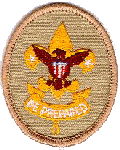|


2004
First Class
Rank Requirements

Changes to these requirements,
which became effective on January 1, 2004,
are shown in Bold Underlined print, similar to this paragraph.
Deletions are shown struck
through in red italics, like this text.
Unchanged text is shown like this.
The change shown below appears in the 2004 edition of
Boy Scout Requirements (No. 33215) but is not listed on the inside
Front Cover of that booklet.
To see the requirements with no
highlighting of the changes,
Click Here
NOTE: These requirements, and those for Tenderfoot and Second Class
may be worked on simultaneously; however these ranks must be earned in
sequence.
- Demonstrate how to find directions during the day and at night
without using a compass.
- Using a compass, complete an orienteering course that covers at
least one mile and requires measuring the height and/or width of
designated items (tree, tower, canyon, ditch, etc.)
- Since joining, have participated in ten separate troop/patrol
activities (other than troop/patrol meetings), three of which included
camping overnight.
- a. Help plan a patrol menu for one campout
including that includes at
least one breakfast, one lunch, and one
dinner and that requires cooking at least two meals.
Tell how the menu includes the foods from the food pyramid and meets
nutritional needs.
- b. Using the menu planned in requirement 4a, make a list
showing the cost and food amounts needed to feed three or more boys and
secure the ingredients.
- c. Tell which pans, utensils, and other gear will be
needed to cook and serve these meals.
- d. Explain the procedures to follow in the safe handling
and storage of fresh meats, dairy products, eggs, vegetables, and other
perishable food products. Tell how to properly dispose of camp
garbage, cans, plastic containers, and other rubbish.
- e. On one campout, serve as your patrol's cook.
Supervise your assistant(s) in using a stove or building a cooking fire.
Prepare the breakfast, lunch, and dinner planned in requirement 4a.
Lead your patrol in saying grace at the meals and supervise cleanup.
- Visit and discuss with a selected individual approved by
your leader (elected official, judge, attorney, civil servant,
principal, teacher) your Constitutional rights and obligations as a U.S.
citizen.
- Identify or show evidence of at least ten kinds of native
plants found in your community.
- a. Discuss when you should and should not use lashings
- b. Demonstrate tying the timber hitch and clove hitch and
their use in square, shear, and diagonal lashings by joining two or more
poles or staves together.
- c. Use lashing to make a useful camp gadget.
- a. Demonstrate tying the bowline knot and describe several
ways it can be used.
- b. Demonstrate bandages for a sprained ankle. and for
injuries on the head, the upper arm, and the collarbone.
- c. Show how to transport by yourself, and with one other
person, a person:
- from a smoke-filled room
- with a sprained ankle, for at least 25 yards.
- d. Tell the five most common signs of a heart attack.
Explain the steps (procedures) in cardiopulmonary resuscitation (CPR).
- a. Tell what precautions must be taken for a safe trip
afloat.
- b. Successfully complete the
BSA swimmer
test.
- c.
With a helper and a practice victim, show a line rescue both as tender
and rescuer. (The practice victim should be approximately 30 feet
from shore in deep water.)
- Demonstrate scout spirit by living the Scout Oath
(Promise) and Scout Law in your everyday life.
- Participate in a Scoutmaster conference.
- Complete your board of review.
NOTE: Alternate Requirements
for the First Class rank are available for Scouts with
physical or mental disabilities if they meet the criteria listed in the
Boy Scout Requirements book. (No. 33215E)
Please note that Requirement 12 - (Complete your
Board of Review) MAY be done AFTER the Scout has reached age 18.
All other requirements must be completed BEFORE the Scout's 18th Birthday. |